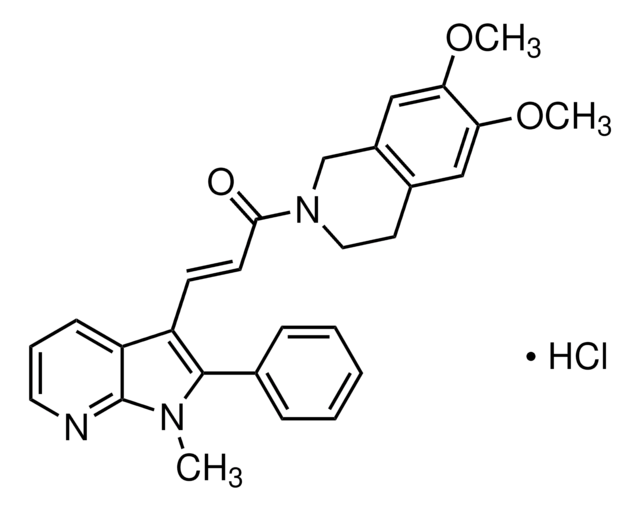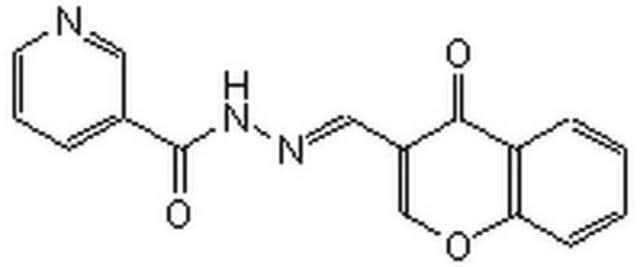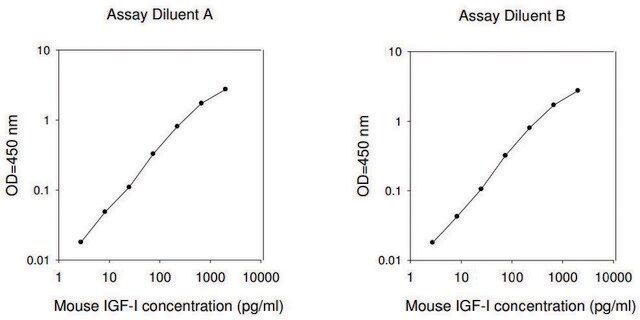566405
SIS3
≥90% (HPLC), solid, Smad3 inhibitor, Calbiochem®
Synonim(y):
SIS3, 6,7-dimetoksy-2-((2E)-3-(1-metylo-2-fenylo-1H-pirololo[2,3-b]pirydyn-3-ylo-prop-2-enylo))-1,2,3,4-tetrahydroizochinolina, specyficzny inhibitor Smad 3
About This Item
Polecane produkty
Nazwa produktu
Smad3 Inhibitor, SIS3, Smad3 Inhibitor, SIS3, CAS 1009104-85-1, is a cell-permeable, selective inhibitor of TGF-β1-dependent Smad3 phosphorylation and Smad3-mediated signaling. Does not affect Smad2, MAPK, ERK, or PI3-K.
Poziom jakości
Próba
≥90% (HPLC)
Formularz
solid
producent / nazwa handlowa
Calbiochem®
warunki przechowywania
OK to freeze
protect from light
kolor
off-white
rozpuszczalność
DMSO: 15 mg/mL
ethanol: 5 mg/mL
Warunki transportu
ambient
temp. przechowywania
2-8°C
ciąg SMILES
[n]1(c2ncccc2c(c1c5ccccc5)C=CC(=O)N3CCc4c(cc(c(c4)OC)OC)C3)C
InChI
1S/C28H27N3O3/c1-30-27(19-8-5-4-6-9-19)22(23-10-7-14-29-28(23)30)11-12-26(32)31-15-13-20-16-24(33-2)25(34-3)17-21(20)18-31/h4-12,14,16-17H,13,15,18H2,1-3H3
Klucz InChI
IJYPHMXWKKKHGT-UHFFFAOYSA-N
Zastosowanie
Działania biochem./fizjol.
TGF-β1-dependent Smad3 phosphorylation and Smad3-mediated cellular signaling
Opakowanie
Ostrzeżenie
Rekonstytucja
Inne uwagi
Product does not compete with ATP.
Cell permeable: yes
Jinnin, M., et al. 2006. Mol. Pharmacol.69, 597.
Informacje prawne
Kod klasy składowania
11 - Combustible Solids
Klasa zagrożenia wodnego (WGK)
WGK 1
Temperatura zapłonu (°F)
Not applicable
Temperatura zapłonu (°C)
Not applicable
Certyfikaty analizy (CoA)
Poszukaj Certyfikaty analizy (CoA), wpisując numer partii/serii produktów. Numery serii i partii można znaleźć na etykiecie produktu po słowach „seria” lub „partia”.
Masz już ten produkt?
Dokumenty związane z niedawno zakupionymi produktami zostały zamieszczone w Bibliotece dokumentów.
Klienci oglądali również te produkty
Nasz zespół naukowców ma doświadczenie we wszystkich obszarach badań, w tym w naukach przyrodniczych, materiałoznawstwie, syntezie chemicznej, chromatografii, analityce i wielu innych dziedzinach.
Skontaktuj się z zespołem ds. pomocy technicznej











